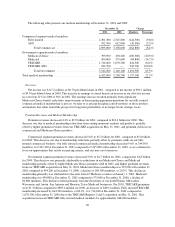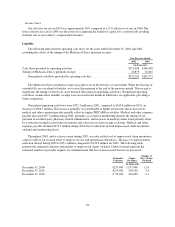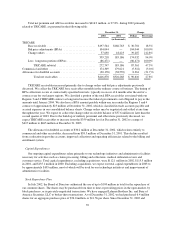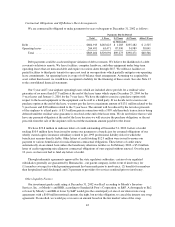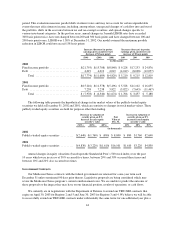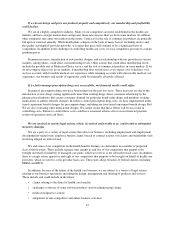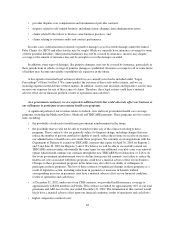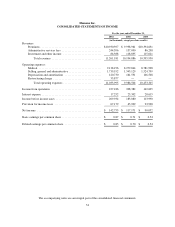Humana 2002 Annual Report Download - page 52
Download and view the complete annual report
Please find page 52 of the 2002 Humana annual report below. You can navigate through the pages in the report by either clicking on the pages listed below, or by using the keyword search tool below to find specific information within the annual report.If the premiums we charge are insufficient to cover the cost of health care services delivered to our
members, or if our estimates of medical claim reserves are inadequate, our profitability could decline.
We use a significant portion of our revenues to pay the costs of health care services delivered to our
members. These costs include claims payments, capitation payments, allocations of some centralized expenses
and various other costs incurred to provide health insurance coverage to our members. These costs also include
estimates of future payments to hospitals and others for medical care provided to our members. Generally,
premiums in the health care business are fixed for one-year periods. Accordingly, costs we incur in excess of our
medical cost projections generally are not recovered in the contract year through higher premiums. We estimate
the costs of our future medical claims and other expenses using actuarial methods and assumptions based upon
claim payment patterns, medical inflation, historical developments, including claim inventory levels and claim
receipt patterns, and other relevant factors. We also record medical claims reserves for future payments. We
continually review estimates of future payments relating to medical claims costs for services incurred in the
current and prior periods and make necessary adjustments to our reserves. However, increased utilization or unit
cost, competition, government regulations and many other factors may and often do cause actual health care costs
to exceed what was estimated and reflected in premiums.
These factors may include:
• increased use of medical facilities and services, including prescription drugs;
• increased cost of such services;
• termination of capitation arrangements resulting in the transfer of membership to fee-for-service
arrangements;
• changes or reductions of our utilization management functions such as preauthorization of services,
concurrent review or requirements for physician referrals;
• catastrophes or epidemics;
• the introduction of new or costly treatments, including new technologies;
• medical cost inflation;
• new government mandated benefits or other regulatory changes; and
• increased use of health care, including doctors’ office visits and prescriptions resulting from terrorists’
attacks and subsequent terrorists threats, including bioterrorism.
Failure to adequately price our products or estimate sufficient medical claim reserves may result in a
material adverse effect on our financial position, results of operations and cash flows.
If we fail to effectively implement our operational and strategic initiatives, our business could be
materially adversely affected.
Our future performance depends in large part upon our management team’s ability to execute our strategy to
position the company for the future. This strategy includes the growth of our Commercial segment business,
introduction of new products and benefit designs, the successful implementation of our e-business initiatives and
the selection and adoption of new technologies. We believe that the adoption of new technologies will contribute
toward a reduction in administrative costs as we more closely align our workforce with our membership. There
can be no assurance that we will be able to successfully implement our operational and strategic initiatives that
are intended to position the company for future growth. Failure to implement this strategy may result in a
material adverse effect on our financial position, results of operations and cash flows.
46


